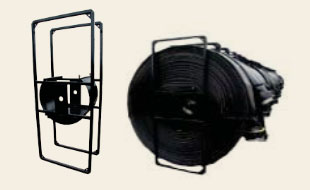TPU Layflat Hose
Designed for produced water/fresh water transfer. Typically used for hydraulic fracture water transfer, to replace damaged hydrant lines, or to replace a broken water main. Manufactured with NSF standard 61 approved materials for use with potable water.
Construction Polyurethane Extruded Through the Weave and a Circular Polyester Woven Reinforcement. No use of glues or adhesives.
Safety Factor Minimum 2.25 to 1
Lining Properties
Ultimate Tensile Strength no less than 1200 psi / ~82 Bar / ~8,270 Kpa
Ultimate Elongation when tested to UL-19 guidelines a small dumbbell sample of lining elongates a minimum of 400%
Resistance
Abrasion 25mm3 on DIN 53516/ISO4649 testing, up to 5 times more resistant and 50% more puncture resistant than Nitrile/PVC
Cold Remains flexible in as low as -40°C conditions
Ozone No cracking in lining or cover when tested to ASTM D518 Procedure B (100 pphm/48°C/70 hours)
Chemical Resistant to most chemicals and petroleum products
Custom hose colour and branding available on big volume orders
| ID |
Wall Thickness |
Maximum Working Pressure |
Elongation |
Expansion |
Weight |
Reel Length |
| (mm) |
(mm) |
(psi/Bar/Kpa) |
% at WP |
% at WP |
Kg/200m |
Metres |
| 100 |
3.99 |
250 / 17.2 / 1,723 |
1.0 |
3.4 |
302 |
200 |
| 150 |
4.09 |
250 / 17.2 / 1,723 |
1.0 |
3.2 |
482 |
200 |
| 200 |
4.19 |
200 / 13.7 / 1,378 |
0.7 |
3.0 |
644 |
200 |
| 250 |
4.19 |
200 / 13.7 / 1,378 |
0.5 |
2.8 |
859 |
200 |
| 300 |
4.98 |
150 / 10.3 / 1,034 |
0.5 |
2.6 |
1,117 |
200 |
Through-the-Weave vs. 3-Ply Layflat Hose
Compared with hoses made from a blend of nitrile rubber and PVC, urethane hose offers 5X the abrasion resistance, less elongation, and far superior puncture resistance.
Polyurethane (PU) hose, is manufactured a couple different ways: “three-ply” and “through-the-weave.” 3-ply hose is relatively labour intensive, where a long tube of urethane is glued over a woven polyester hose jacket. Then it is turned inside-out, and an outer PU cover is glued to the other side of the jacket. The final step is to fill the hose with steam, which cures the glue and creates the adhesion between the various layers. It’s important to note that the outer layer of urethane is pin-pricked with thousands of small holes to allow gases to escape during the steam curing process.
Through-the-weave layflat hose also begins with a woven polyester hose jacket. However, at the end of a plastics extruder is specialised tooling, through which the jacket is penetrated and coated with hot, molten thermoplastic polyurethane (TPU). The urethane, in liquid form at such a high temperature, is literally forced through all the gaps in the weave of the hose jacket. The hose exits the die and begins to cool immediately. Urethane completely encapsulates the woven jacket and provides a watertight hose wall as well as incredibly tough protection for the hose jacket. The hose jacket, in turn, provides all the pressure capability for the hose, as well as limiting elongation and expansion. Once the hose is cooled it is fully formed, then coiled on a reel and ready to be tested. This through-the-weave method is a more difficult manufacturing process than 3-ply, but well worth the extra difficulty as it results in a much stronger final product.
We’ve chosen to supply our customers a through-the-weave layflat product, as we believe modern through-the-weave construction represents the best design in today’s large diameter layflat hose. 3-ply hose technology is adapted from the fire hose industry, a manufacturing technology that has been around for at least 140 years.
Our layflat hose uses no glues or adhesives which prematurely fail when exposed to moisture, heat, UV exposure, repeated flexing, or dry out naturally over longer periods of time. Our layflat hose is free of pinholes and the cover will not delaminate. Rather than sit on top of the woven polyester, our TPU is an integral part of the hose, working in concert with the hose jacket. Our hose will not “snake” along the ground due to excessive elongation.


 Stands upright by itself – round reels need a cradle
Stands upright by itself – round reels need a cradle Coil and deploy driving forward. Can deploy one 200m length in less than a minute consistently (level ground)
Coil and deploy driving forward. Can deploy one 200m length in less than a minute consistently (level ground)